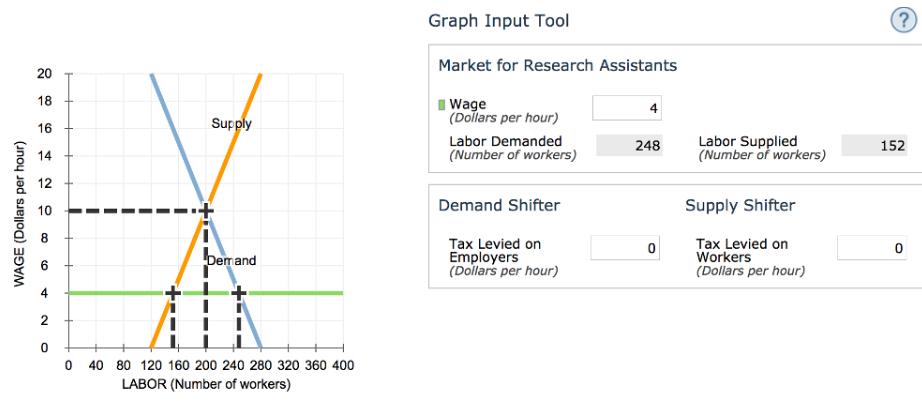Question
The following graph shows the labor market for research assistants in the fictional country of Collegia. The equilibrium wage is $10 per hour, and the
The following graph shows the labor market for research assistants in the fictional country of Collegia. The equilibrium wage is $10 per hour, and the equilibrium number of research assistants is 100.
Suppose the government has decided to institute a $4-per-hour payroll tax on research assistants and is trying to determine whether the tax should be levied on the employer, the workers, or both (such that half the tax is collected from each side).
Use the graph input tool to evaluate these three proposals. Entering a number into the Tax Levied on Employers field (initially set at zero dollars per hour) shifts the demand curve down by the amount you enter, and entering a number into the Tax Levied on Workers field (initially set at zero dollars per hour) shifts the supply curve up by the amount you enter. To determine the before-tax wage for each tax proposal, adjust the amount in the Wage field until the quantity of labor supplied equals the quantity of labor demanded. You will not be graded on any changes you make to this graph.
Note: Once you enter a value in a white field, the graph and any corresponding amounts in each grey field will change accordingly.

For each of the proposals, use the previous graph to determine the new number of research assistants hired. Then compute the after-tax amount paid by employers (that is, the wage paid to workers plus any taxes collected from the employers) and the after-tax amount earned by research assistants (that is, the wage received by workers minus any taxes collected from the workers).

Suppose the government is concerned that research assistants already make too little money and, therefore, wants to minimize the share of the tax paid by employees. Of the three tax proposals, which is best for accomplishing this goal? The proposal in which the entire tax is collected from workers The proposal in which the tax is collected from each side evenly The proposal in which the tax is collected from employers None of the proposals is better than the others 
Graph Input Tool (? Market for Research Assistants 20 I Wage (Dollars per hour) 18 4 16 Supply Labor Demanded Labor Supplied (Number of workers) 248 152 14 (Number of workers) 12 10 Demand Shifter Supply Shifter Tax Levied on Employers (Dollars per hour) Tax Levied on Workers (Dollars per hour) Demand 40 80 120 160 200 240 280 320 360 400 LABOR (Number of workers) 4. 2. WAGE (Dollars per hour)
Step by Step Solution
3.43 Rating (153 Votes )
There are 3 Steps involved in it
Step: 1
Case I Tax amount of 4 per hour payroll tax is paid by the employers In this case the demand curve ...
Get Instant Access to Expert-Tailored Solutions
See step-by-step solutions with expert insights and AI powered tools for academic success
Step: 2

Step: 3

Document Format ( 2 attachments)
60991b3c25748_29390.pdf
180 KBs PDF File
60991b3c25748_29390.docx
120 KBs Word File
Ace Your Homework with AI
Get the answers you need in no time with our AI-driven, step-by-step assistance
Get Started


